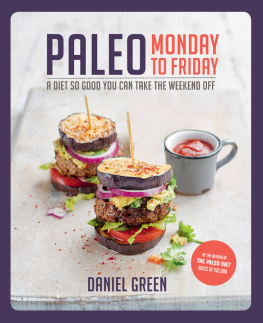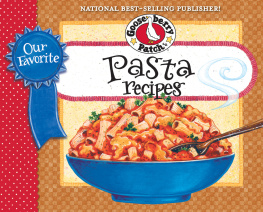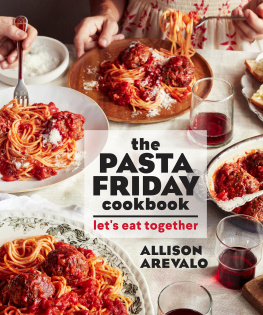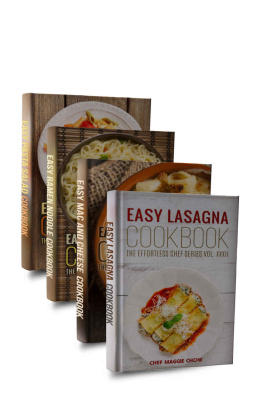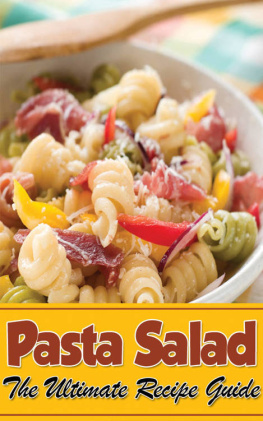MONDAY-TO-FRIDAY
Pasta

MICHELLE URVATER
Illustrations by Simms Taback
WORKMAN PUBLISHING NEW YORK
Copyright 1995 by Michle Urvater
Illustrations 1995 Simms Taback
All rights reserved. No portion of this book may be reproducedmechanically, electronically, or by any other means, including photocopyingwithout written permission of the publisher. Published simultaneously in Canada by Thomas Allen & Son Limited.
Library of Congress Cataloging-in-Publication Data is available.
eISBN 9780761179047
Book illustrations by Simms Taback
Workman books are available at special discounts when purchased in bulk for premium and sales promotions as well as for fund-raising or educational use. Special editions or book excerpts can also be created to specification. For details, contact the Special Sales Director at the address below.
Workman Publishing Company, Inc.
225 Varick Street
New York, NY 10014
www.workman.com
Dedication

For Barbara Kasman, a most passionate pasta lover and most devoted loyal friend
Acknowledgments
I want to thank everyone at Workman Publishing for helping give birth to Monday-to-Friday Pasta, with an especially grateful thank-you to Paul Hanson for his cover concept, a warm thank-you to Suzanne Rafer, the most patient editor in the world, and a loving thank-you to the tireless and ebullient Andrea Glickson in publicity.
As always, I am grateful to my loving husband, Michael, and my wonderful daughter, Alessia, who once again proved to be a perfect pair of enthusiastic yet discriminating tasters.
Pasta: The Monday-to-Friday-Way

Another pasta cookbook? Well, yesbut one with a purpose. Pasta is perfectly suited to todays hectic, health-focused lifestyle. And following my Monday-to-Friday system, it allows the busy cook to put delicious, fresh-tasting, nutritious meals on the table with zero bother.
The Monday-to-Friday Cookbook, which was published in 1991, describes a method for getting dinner on the table every night of the week, after a hard days work and in the face of all sorts of complicated family situations. Not only does it offer easy and quick recipes, it presents a slew of strategies for tackling the everyday obstacles that get in the way of making dinner. The Monday-to-Friday Cookbook explains how to build a pantry, how to get organized, how to plan a menu, and how to vary the recipes so they mesh with individual needs. There is a recap of these principles beginning on page . Toil-free weekday meals are the focus of Monday-to-Friday Pasta tooin this case with pasta as the centerpiece one or two nights of the week.
Why pasta? There cannot be a food that is more universally loved. The fussiest child and the most demanding adult are both easily soothed by a plateful of noodles. Whats more, you can prepare an astonishing array of lovely simple dinners with pasta adding just one or two fresh ingredients and a bit of seasoning. Pasta is also a natural choice because its good for us: Current dietary guidelines exhort us to make grainscereal, bread, and pastathe bulk of our diet.
This is not an encyclopedic treatise that will teach you everything you ever wanted to know about pasta, nor is it a reference book that places the recipes within a historical or cultural framework. It doesnt describe the intricacies and technicalities of making fresh pasta. It does deal with the many ways you can use pasta to create a meal. The recipes are straightforward, with many possible variations. Youll discover for instance that one basic recipe can be an Asian dish or a Middle Eastern one, simply by changing the seasoning. There are lean pasta recipes that you can make for yourself and extravagant ones you can share. Youll learn how to make pasta dishes in the form of main-course soups and even desserts. Youll find out how to make a pasta meal out of leftovers in the fridge, and youll even acquire a repertoire of pasta meals that are suited for those busy nights when members of your family have to eat at different times. Youll find uncomplicated pasta meals that will please the younger set and youll learn how to exploit the seasons by making pasta dishes with produce at its peak.
THE MONDAY-TO-FRIDAY SYSTEM
Monday-to-Friday cooking means getting a delicious dinner on the table with little effort while coping with the hassled weekdays we all facewhether we are single or married, working outside of the home or tending to a brood of kids. There arent enough hours in the day to accomplish all we need to do, and who has the patience to prepare an elaborate meal at the end of the day? The Monday-to-Friday system of cooking lets us enjoy flavorful, nutritious meals and gain a little time to relax, read a bedtime story, or catch up with friends. All it takes is a little organizing: Stock up on a few ingredients, plan ahead, and take it easy!
THE PANTRY
If you dont have any food in the house, you cant make dinner. And, six or seven oclock in the evening is not the best time to start thinking about what to cook. Heres where the pantry comes to your rescue. It is the stash of provisions that you should have on hand in the cupboard, as well as in the fridge and in the freezer. Some of these ingredients can become the main course, some the accompaniments to the main course, and others the seasonings that dress up the main course and its sidekick.
The ideal pantry contains all the fixings even without a single fresh ingredient in the house. But more important, the contents of the pantry stand ready to be combined with fresh ingredients to help you to create from scratch whenever you like.

THE CALENDAR
I suggest that you set up a calendar on which to jot down menu ideas. I keep an erasable monthly calendar on my refrigeratorits held there with magnets. You can also buy a plain sheet of erasable plastic (the kind you write on with washable ink) and draw your calendar on it. Or create a model calendar on your computer and print out a new version every week or every month. Or, simpler yet, use a sheet of ordinary paper for scribbling your weekly menus.
Jot down the type of meal youd like to serve each day of the upcoming work-week. It doesnt have to be a precise menu, just the sketch of one. For example, for Monday night I might scribble pasta and veggie, for Tuesday dinner chicken and salad, for Wednesday rice, beans, and vegetable, for Thursday fish, starch, salad and for Friday night clean out the fridge or maybe treat the family to take-out-food.
By jotting down even that much, I know to put on my shopping list at least those main-course ingredients I need in order to cook my planned dinners. This way, I minimize the trips to the supermarket. I might not know yet how I will cook that chicken, but I have to begin by buying some chicken so that I can fix it later. I still have the freedom to decide how to prepare the chicken when the time comes. The recipe I end up using might be dictated by some ingredient in the pantry, or by a vegetable that looks especially fresh at the market, or maybe by a scheduling consideration.
Next page

